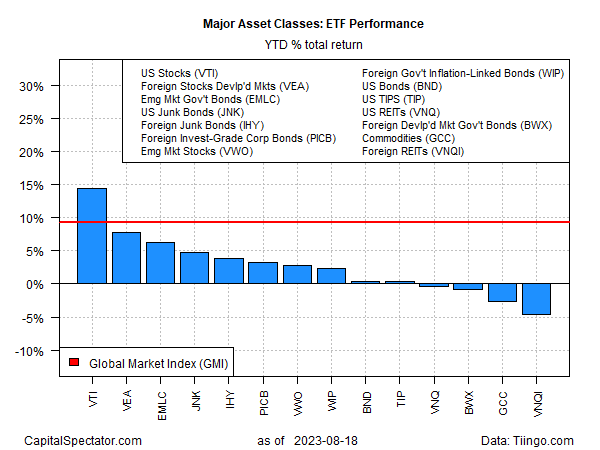All the major asset classes fell last week, extending a run of risk-off sentiment of late based on a set of ETF proxies. Investors are struggling to decide if the latest decline is noise or marks the end of the rally in risk assets that started in late 2022 and, for now, peaked last month.
One reason to reserve judgment: year-to-date performances remain positive for most markets. Notably, US equities are still the leader in 2023 through Friday’s close (Aug. 18). Vanguard Total Stock Market Index Fund ETF Shares (NYSE:) is up 14.4% so far this year. The US bond market, by contrast, is virtually flat, based on the Vanguard Total Bond Market Index Fund ETF Shares (NASDAQ:).
The worst performer for the major asset classes year to date: foreign property stocks. Vanguard Global ex-U.S. Real Estate Index Fund ETF Shares (NASDAQ:) has shed nearly 5% in 2023.
The Global Market Index (GMI) is still posting a solid gain for 2023, ending Friday with a near-10% advance, despite recent weakness. This unmanaged benchmark holds all the major asset classes (except cash) in market-value weights via ETFs and represents a competitive measure for multi-asset-class portfolio strategies.

ETF Performance YTD Returns
Two risk factors have been weighing on investor sentiment lately: China’s struggles with growth, which has ramifications for the global economy. Meanwhile, the renewed rise in US Treasury yields has sparked fresh concerns that peak rates for America still lie ahead.
The Wall Street Journal notes that higher estimates lately of the so-called neutral rate — the estimated rate that aligns with a balance of supply and fosters full employment and price stability – imply that US interest rates need to rise further.
With inflation now falling but [economic] activity still firm, estimates of the neutral rate could take on greater importance in coming months. If neutral has gone up, that could call for higher short-term interest rates, or delay interest-rate cuts as inflation falls. It could also keep long-term bond yields, which determine rates on mortgages and corporate debt, higher for longer.
Meanwhile, the economic slowdown in China, in part driven by a property slump that’s been years in the making, has caught the attention of global markets. The country’s central bank the country’s prime 1-year lending rate again today, but some economists say much more needs to be done to address China’s brewing economic troubles.
“The underwhelming LPR announcement strengthens our view that the PBOC is unlikely to embrace the much larger rates cuts that would be required to revive credit demand,” advises Julian Evans-Pritchard, Capital Economics’ head of China, in a note. “Hopes for a stimulus-led turnaround in economic activity largely depend on the prospect of greater fiscal support.”
The sight of inflation and growth factors animating macro concerns in the US contrasts with disinflation/deflation risk in China. The world’s two largest economies are, in effect, facing a diverging set of challenges.
The details could get messy for markets, delivering unexpected results. There’s precious little precedent in modern history for the US and China moving along distinctly different economic paths. Sorting out what it all means for markets will take time. Meantime, investors have turned wary, which will likely continue until there’s more confidence about what comes next.

